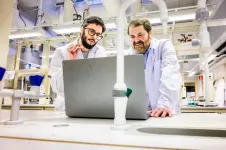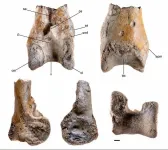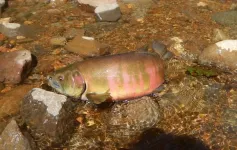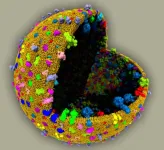(Press-News.org) Researchers have identified 22 pesticides consistently associated with the incidence of prostate cancer in the United States, with four of the pesticides also linked with prostate cancer mortality. The findings are published by Wiley online in CANCER, a peer-reviewed journal of the American Cancer Society.
To assess county-level associations of 295 pesticides with prostate cancer across counties in the United States, investigators conducted an environment-wide association study, using a lag period between exposure and prostate cancer incidence of 10–18 years to account for the slow-growing nature of most prostate cancers. The years 1997–2001 were assessed for pesticide use and 2011–2015 for prostate cancer outcomes. Similarly, 2002–2006 were analyzed for pesticide use and 2016–2020 for outcomes.
Among the 22 pesticides showing consistent direct associations with prostate cancer incidence across both time-based analyses were three that had previously been linked to prostate cancer, including 2,4-D, one of the most frequently used pesticides in the United States. The 19 candidate pesticides not previously linked to prostate cancer included 10 herbicides, several fungicides and insecticides, and a soil fumigant.
Four pesticides that were linked to prostate cancer incidence were also associated with prostate cancer mortality: three herbicides (trifluralin, cloransulam-methyl, and diflufenzopyr) and one insecticide (thiamethoxam). Only trifluralin is classed by the Environmental Protection Agency as a “possible human carcinogen,” whereas the other three are considered “not likely to be carcinogenic” or have evidence of “non-carcinogenicity.”
“This research demonstrates the importance of studying environmental exposures, such as pesticide use, to potentially explain some of the geographic variation we observe in prostate cancer incidence and deaths across the United States,” said lead author Simon John Christoph Soerensen, MD, of Stanford University School of Medicine. “By building on these findings, we can advance our efforts to pinpoint risk factors for prostate cancer and work towards reducing the number of men affected by this disease.”
Additional information
NOTE: The information contained in this release is protected by copyright. Please include journal attribution in all coverage. A free abstract of this article will be available via the CANCER Newsroom upon online publication. For more information or to obtain a PDF of any study, please contact: Sara Henning-Stout, newsroom@wiley.com
Full Citation:
“Pesticides and Prostate Cancer Incidence and Mortality: An Environmental Wide Association Study.” Simon John Christoph Soerensen, David S. Lim, Maria E. Montez-Rath, Glenn M. Chertow, Benjamin I. Chung, David H. Rehkopf, and John T. Leppert. CANCER; Published Online: November 4, 2024 (DOI: 10.1002/cncr.35572).
URL Upon Publication: http://doi.wiley.com/10.1002/cncr.35572
University Media Representative’s Contact: Ahmad Zaki Sadeqi, MSc, MA; Communications Manager, Department of Urology, Stanford University School of Medicine; Email: azsadeqi@stanford.edu
About the Journal
CANCER is a peer-reviewed publication of the American Cancer Society integrating scientific information from worldwide sources for all oncologic specialties. The objective of CANCER is to provide an interdisciplinary forum for the exchange of information among oncologic disciplines concerned with the etiology, course, and treatment of human cancer. CANCER is published on behalf of the American Cancer Society by Wiley and can be accessed online. Follow CANCER on X @JournalCancer and Instagram @ACSJournalCancer, and stay up to date with the American Cancer Society Journals on LinkedIn.
About Wiley
Wiley is one of the world’s largest publishers and a trusted leader in research and learning. Our industry-leading content, services, platforms, and knowledge networks are tailored to meet the evolving needs of our customers and partners, including researchers, students, instructors, professionals, institutions, and corporations. We empower knowledge-seekers to transform today’s biggest obstacles into tomorrow’s brightest opportunities. For more than two centuries, Wiley has been delivering on its timeless mission to unlock human potential. Visit us at Wiley.com. Follow us on Facebook, X, LinkedIn and Instagram.
END
Study reveals links between many pesticides and prostate cancer
US county-level data point to specific pesticides that may increase prostate cancer incidence and death
2024-11-04
ELSE PRESS RELEASES FROM THIS DATE:
LiU researchers make AlphaFold predict very large proteins
2024-11-04
The AI tool AlphaFold has been improved so that it can now predict the shape of very large and complex protein structures. Linköping University researchers have also succeeded in integrating experimental data into the tool. The results, published in Nature Communications, are a step toward more efficient development of new proteins for, among other things, medical drugs.
In all living organisms, there is a huge variety of proteins that regulate cell functions. Basically, everything that happens in the body, from controlling muscles and forming hair to transporting ...
Fossil of huge terror bird offers new information about wildlife in South America 12 million years ago
2024-11-04
**EMBARGOED UNTIL RELEASE MONDAY, NOV. 4, AT 1 A.M. ET**
Researchers including a Johns Hopkins University evolutionary biologist report they have analyzed a fossil of an extinct giant meat-eating bird — which they say could be the largest known member of its kind — providing new information about animal life in northern South America millions of years ago.
The evidence lies in the leg bone of the terror bird described in new paper published Nov. 4 in Palaeontology. The study was led by Federico J. Degrange, a terror bird ...
Scientists create a world-first 3D cell model to help develop treatments for devastating lip injuries
2024-11-04
We use our lips to talk, eat, drink, and breathe; they signal our emotions, health, and aesthetic beauty. It takes a complex structure to perform so many roles, so lip problems can be hard to repair effectively. Basic research is essential to improving these treatments, but until now, models using lip cells — which perform differently to other skin cells — have not been available. In a new study published in Frontiers in Cell and Developmental Biology, scientists report the successful immortalization of donated lip cells, ...
One-third of patients with cancer visit EDs in months before diagnosis
2024-11-04
About 1 in 3 patients diagnosed with cancer in Ontario visited an emergency department (ED) in the 90 days before diagnosis, found a new study published in CMAJ (Canadian Medical Association Journal) https://www.cmaj.ca/lookup/doi/10.1503/cmaj.240952.
In a study that included more than 650 000 patients diagnosed with cancer between 2014 and 2021 in Ontario, 35% (229 683) had visited an ED in the 90 days before diagnosis. Among patients with ED visits before their cancer diagnosis, 64% had visited once, 23% had visited twice and 13% had 3 or more visits. ...
Adolescent exam anxiety can be intensified by pressure to achieve, says academic
2024-11-04
Former teacher Professor of Education David Putwain says ‘heavy-handed’ messages around test results can fuel extreme worry among some 16 to 18-year-olds, even when others respond well to such messages.
Putwain identifies several risk factors, for example students with certain personality traits, including those who are highly self-critical, can underachieve because of severe anxiety in exams. Certain demographics also report higher exam anxiety, including female persons and those from economically deprived backgrounds.
‘Temperature checks’ to identify at-risk ...
A digital health behavior intervention to prevent childhood obesity
2024-11-03
About The Study: A health literacy-informed digital intervention improved child weight-for-length trajectory across the first 24 months of life and reduced childhood obesity at 24 months. The intervention was effective in a racially and ethnically diverse population that included groups at elevated risk for childhood obesity.
Corresponding Author: To contact the corresponding author, William J. Heerman, MD, MPH, email Bill.Heerman@vumc.org.
To access the embargoed study: Visit our For The Media website at this link https://media.jamanetwork.com/
(doi:10.1001/jama.2024.22362)
Editor’s ...
Preventing obesity in very young children could be in the palm of parents’ hands
2024-11-03
A study co-led by a Johns Hopkins Children’s Center clinician-researcher shows that adding text messaging and other electronic feedback to traditional in-clinic health counseling for parents about feeding habits, playtime and exercise prevents very young children from developing obesity and potentially lifelong obesity-related problems.
Findings from the study, which was co-led by Eliana Perrin, M.D., M.P.H., Bloomberg Distinguished Professor of Primary Care at the Johns Hopkins University Schools of Medicine, Nursing and Public Health, will be published in JAMA and presented at the Obesity Society’s “Obesity Week” in San Antonio, both on Nov. ...
Mathematical model illuminates how environment impacts life choices of salmon
2024-11-02
Tokyo, Japan – Researchers from Tokyo Metropolitan University have created a mathematical model that models how the evolutionary strategies of organisms are affected by the environment. They studied salmonid fishes which choose either to migrate to the sea then return to lay eggs or stay in the river depending on their individual features. Their model correctly predicts how the proportion choosing to migrate changes with environmental conditions, predicting how environmental change can trigger eco-evolutionary responses.
Salmonids (or salmon-like) fish are known to face a tough choice early in their lives. They can either stay where they are ...
Houston Methodist researchers shed light on increased rates of severe human infections caused by Streptococcus subspecies
2024-11-01
HOUSTON-(Nov. 1, 2024) – A concerning increase in global rates of severe invasive infections becoming resistant to key antibiotics has a team of infectious disease researchers at the Houston Methodist Research Institute studying a recently emerged strain of bacteria called Streptococcus dysgalactiae subspecies equisimilis (SDSE). SDSE infects humans via the skin, throat, gastrointestinal tract and female genital tract to cause infections ranging in severity from strep throat (pharyngitis) to necrotizing fasciitis (flesh-eating disease).
Closely related to group A streptococcus (also commonly known as Streptococcus pyogenes), which has been very well studied, ...
Auburn University hosts 62nd Hands-On Workshop on Computational Biophysics, featuring the new VMD 2.0
2024-11-01
AUBURN, Ala. – The NIH Center for Macromolecular Modeling and Visualization and Auburn University are pleased to announce the 62nd Hands-On Workshop on Computational Biophysics, taking place from December 16-20, 2024, at Auburn University’s Department of Physics. This prestigious workshop series, first launched in June 2003 by the Theoretical and Computational Biophysics Group at the University of Illinois at Urbana-Champaign, has become a premier global training event in molecular modeling. Supported by NIH, the workshop provides a unique platform for researchers across disciplines to master the latest computational biophysics techniques.
This year’s ...
LAST 30 PRESS RELEASES:
NSF–DOE Vera C. Rubin Observatory spots record-breaking asteroid in pre-survey observations
Ribosomal engineering creates “super-probiotic” bacteria
This self-powered eye tracker harnesses energy from blinking and is as comfortable as everyday glasses
Adverse prenatal exposures linked to higher rates of mental health issues, brain changes in adolescents
Restoring mitochondria shows promise for treating chronic nerve pain
Nature study identifies a molecular switch that controls transitions between single-celled and multicellular forms
USU chemists' CRISPR discovery could lead to single diagnostic test for COVID, flu, RSV
Early hominins from Morocco reveal an African lineage near the root of Homo sapiens
Small chimps, big risks: What chimps show us about our own behavior
We finally know how the most common types of planets are created
Thirty-year risk of cardiovascular disease among healthy women according to clinical thresholds of lipoprotein(a)
Yoga for opioid withdrawal and autonomic regulation
Gene therapy ‘switch’ may offer non-addictive pain relief
Study shows your genes determine how fast your DNA mutates with age
Common brain parasite can infect your immune cells. Here's why that's probably OK
International experts connect infections and aging through cellular senescence
An AI–DFT integrated framework accelerates materials discovery and design
Twist to reshape, shift to transform: Bilayer structure enables multifunctional imaging
CUNY Graduate Center and its academic partners awarded more than $1M by Google.org to advance statewide AI education through the Empire AI consortium
Mount Sinai Health system receives $8.5 million NIH grant renewal to advance research on long-term outcomes in children with congenital heart disease
Researchers develop treatment for advanced prostate cancer that could eliminate severe side effects
Keck Medicine of USC names Christian Pass chief financial officer
Inflatable fabric robotic arm picks apples
MD Anderson and SOPHiA GENETICS announce strategic collaboration to accelerate AI-driven precision oncology
Oil residues can travel over 5,000 miles on ocean debris, study finds
Korea University researchers discover that cholesterol-lowering drug can overcome chemotherapy resistance in triple-negative breast cancer
Ushikuvirus: A newly discovered giant virus may offer clues to the origin of life
Boosting the cell’s own cleanup
Movement matters: Light activity led to better survival in diabetes, heart, kidney disease
Method developed to identify best treatment combinations for glioblastoma based on unique cellular targets
[Press-News.org] Study reveals links between many pesticides and prostate cancerUS county-level data point to specific pesticides that may increase prostate cancer incidence and death



